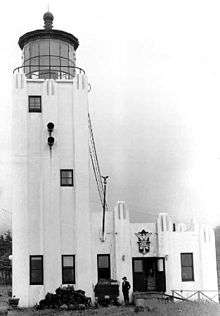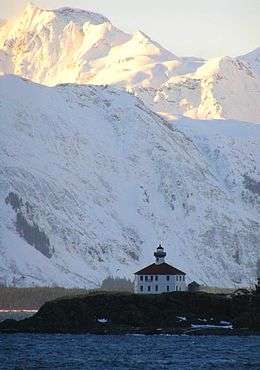Cape Hinchinbrook Light
 Cape Hinchinbrook Light | |
 Alaska | |
| Location |
Hinchinbrook Island Prince William Sound Alaska United States |
|---|---|
| Coordinates | 60°14′15″N 146°38′48″W / 60.23750°N 146.64667°WCoordinates: 60°14′15″N 146°38′48″W / 60.23750°N 146.64667°W |
| Year first constructed | 1910 (first) |
| Year first lit | 1934 (current) |
| Automated | 1974 |
| Foundation | concrete and rock |
| Construction | reinforced concrete tower |
| Tower shape | octagonal prism tower with lantern |
| Markings / pattern |
art deco architecture white tower, black lantern |
| Height | 67 feet (20 m) |
| Focal height | 237 feet (72 m) |
| Original lens | Third order Fresnel lens (Now on display) |
| Current lens | Vega lens |
| Light source | solar power |
| Range | 19 nautical miles (35 km; 22 mi) |
| Characteristic |
Fl W 15s. obscured from 134° to 135° and 138° to 283° emergency light, Fl W 6s. of reduced intensity if main light is extinguished.[1] |
| Admiralty number | G6592 |
| ARLHS number | ALK-002 |
| USCG number | 6-1125 |
| Managing agent |
United States Coast Guard[2] |
|
Cape Hinchinbrook Light Station | |
| Nearest city | Cordova, Alaska |
| Area | 6.9 acres (2.8 ha) |
| Architect | Chase, D.A.; Laird, Edwin |
| Architectural style | Art Deco, Other |
| MPS | Light Stations of the United States MPS |
| NRHP Reference # | 05000728[3] |
| Added to NRHP | July 29, 2005 |
The Cape Hinchinbrook Light is a lighthouse located near the southern end of Hinchinbrook Island adjacent to Prince William Sound, in Alaska, United States.
History

The Cape Hinchinbrook Lighthouse was first established in 1910 to mark the entrance to Prince William Sound. Congress authorized the construction of a lighthouse at this point in 1906 appropriating $125,000 for its construction. However, the full amount was not authorized in one lump sum. The money was appropriated over a number of years with $25,000 in 1906, $50,000 in 1907 and the rest in 1908. As a result, construction did not begin until 1909. In the winter of 1909 a temporary fixed white light was established on the second story of the building under construction. Due to the earthquakes in 1927 and 1928, which caused instability in the cliff around the lighthouse, it was felt a new light should be built on solid rock. The new 67-foot (20 m) octagonal tower was completed in 1934. The lighthouse was automated in 1974 and a solar-powered Vega lens was installed. The original third order Fresnel lens is on display at the Valdez Museum and Historical Archive in Valdez, Alaska.
It was listed on the National Register of Historic Places as Cape Hinchinbrook Light Station in 2005. The listing was for a historic district including two contributing buildings, three contributing structure, one contributing site, and three contributing objects.[3][4]
See also
- List of lighthouses in the United States
- National Register of Historic Places listings in Valdez-Cordova Census Area, Alaska
References
- ↑ "Inventory of Historic Light Stations: Alaska Lighthouses". National Park Service. 2002-02-13. Retrieved 2008-03-12.
- ↑ Cape Hinchinbrook The Lighthouse Directory. University of North Carolina at Chapel Hill. Retrieved 7 June 2016
- 1 2 National Park Service (2010-07-09). "National Register Information System". National Register of Historic Places. National Park Service.
- ↑ Robert M. Weaver (February 27, 2003). "National Register of Historic Places Registration: Cape Hinchinbrook Light Station / Cape Hinchinbrook Lighthouse (AHRS Site No. COR-095)" (PDF). National Park Service. and accompanying photos
External links
- "Historic Light Station Information and Photography: Alaska". United States Coast Guard Historian's Office.
- Lighthouse Friends — Cape Hinchinbrook Lighthouse
- Rowlett, Russ. "Lighthouses of Alaska". The Lighthouse Directory. University of North Carolina at Chapel Hill.
- Valdez Museum and Historical Archive
- United States Coast Guard
| Wikimedia Commons has media related to Cape Hinchinbrook Lighthouse. |
Template:USA-lighthouse-stub
